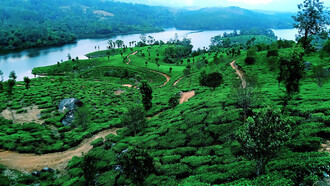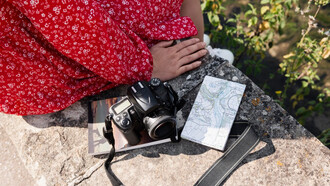The known that became new
In some of my writings, I have shared moments from journeys to distant places — far-flung geographies that carried the allure of the unfamiliar. But few travels have transformed my sense of place as deeply as this one to the Dominican Republic.
Over the years, the island had become part of my travel rhythm. On my frequent trips to Puerto Rico, I often included a stop in Santo Domingo, a day or two on my way in or on my way back. It was a destination I knew well, one that I appreciated, but also one that I had come to expect.
That’s why, when my dear friend Jorge said one afternoon in Puerto Rico, “Let’s go to the Dominican Republic,” I thought I understood what he meant. Visit the Goya plant in Santo Domingo, maybe. A short commercial flight, perhaps a stroll through the Zona Colonial, a quiet night — and then back again.
But Jorge had something entirely different in mind.
Above the sea
We had just finished a routine visit to the Goya plant in Bayamón. Jorge moved through the space like he always did — effortlessly, like someone both at home and in charge. I had been there with him before. The place had its own rhythm: the scent of spices in the air, forklifts gliding between pallets, the sound of workers in motion. Familiar. Grounded. Predictable.
That’s why I didn’t question it when he led me out through a different exit than usual. We passed the loading docks and kept walking until we reached a wide clearing behind the warehouse, where a helipad lay quietly waiting.
He turned to me with a grin that only meant one thing: mischief. “We’re going by helicopter.”
I laughed. Of course, he had arranged this. Jorge had always been fascinated by flight — not just as a way to get somewhere, but as a way to feel free. He asked if I had ever flown in a helicopter, and I said yes — years ago, while photographing Puerto Cabello from above. But that had been work. This was something else. This was Jorge’s idea of fun.
He climbed into the pilot’s seat as if it were the most natural thing in the world. Another friend joined as co-pilot. I settled into the back, more amused than nervous, and surrendered to the moment.
The rotors began their heavy beat, and the ground — the trucks, the plant, the Bayamón skyline — began to slip away.
Then we rose.
Puerto Rico spread beneath us, unfolding like a map. The coastline blurred behind us, and the Caribbean opened wide — endless, blue, alive.
Ahead, Mona Island emerged: small, defiant, perfectly alone. I had seen it before, but never like this. Never so close. Never so real. From above, it looked like a forgotten jewel — a green pulse in a sea of blue.
And suddenly, we weren’t just flying. We were leaving the expected behind.
The coastline unfolds
We landed at Punta Cana to clear immigration. From the air, the approach had been smooth — coastal, open, sunlit. We could see villas with long shadows, swimming pools cut into perfect rectangles, and the green geometry of golf courses reaching toward the sea. It was a coastline already shaped by design, but still surrounded by the immense presence of the Caribbean.
The airport itself felt like an extension of the landscape — light, tropical, familiar. We stepped inside, passed through the border control checkpoint without incident, and returned to the aircraft. There was no real interruption in the atmosphere. Only the steady rhythm of the day.
Jorge checked the fuel. Then, with a quick glance to the west and a satisfied nod, he said: “Let’s follow the coast.”
And so we did.
We lifted again, skimming the shoreline, letting the contours of the island guide us. The northern coast of the Dominican Republic is striking from the air. Hills soften into flatlands, interrupted by fields, mangroves, and long ribbons of sand. The ocean shifts colors — from emerald green to deep indigo — always in motion, always breathing.
Below us, clusters of houses appeared between coves and capes. Some towns hugged the hills; others pressed close to the shore. Fishing boats floated quietly just offshore, anchored in small harbors or pulled up onto beaches.
We followed the coast from Bávaro to Sabana de la Mar, past places I didn’t know by name but recognized by their rhythm: red roofs, open plazas, corner roads leading to the sea. And beyond it all, the inland mountains — blue and distant — rose like a second horizon.
From above, the coastline didn’t astonish with spectacle. It is invited with continuity — a long, unfolding gesture of land and sea, holding its own quiet story.
Rhythms, people, and pulse
After Sabana de la Mar, Jorge veered south. The helicopter traced a loose path over fields, rivers, and quiet towns, gradually descending toward the capital. And then, as if unfolding from the haze, Santo Domingo appeared — its sprawl reaching out from the coastline, its rooftops catching the light.
From above, I could see the layers: the old stone of the Zona Colonial, the geometry of modern buildings, the slow movement of traffic below. The city breathed in contrasts — history and present, rhythm and pause.
We landed at the airport, light still pouring in from the sea. I had arrived in Santo Domingo many times before. Dozens, perhaps. Often, as part of a layover, or on my way somewhere else. But arriving this way — after tracing the coastline, after watching the island open from the air — changed something. The city no longer felt like a point of transit. It felt like an arrival.
And now, whenever I think of the Dominican Republic, this is the memory that comes first. Not the hotels or the headlines.
This moment.
But truthfully, what I’ve always valued most about the Dominican Republic isn’t the terrain — breathtaking as it is — or even the cities.
It’s the people.
Living in the United States, I’ve had the privilege of knowing many Dominicans — in academic settings, in professional collaborations, and in the moments in between. And time after time, they’ve left a lasting impression: friendly, diligent, reliable, and collaborative in ways that go beyond mere efficiency.
In formal contexts, they bring focus and discipline. But outside of work, there’s something else — something unmistakable. A joyful playfulness that colors even the simplest exchange. They laugh easily. They give generously. They move with a rhythm that seems rooted in something deeper than habit.
Dominicans embody resilience — but never lose their brightness. Maybe it’s the island that teaches this: the sun, the sea, the music. A reminder that life is fragile, yes — but always worth celebrating.
In Venezuela, we call it bonchar. And Dominicans, of course, know exactly what that means. It’s not just about partying — it’s about lifting the spirit, turning everyday moments into joy, and refusing to let the weight of the world sink you.
And in that spirit, the music rises — not as background, but as heartbeat.
Bachata and memory
Music is the soul of the Dominican Republic. You cannot speak of this island without mentioning merengue and bachata. They are not just rhythms — they are languages, living traditions, emotional shorthand. Music here doesn’t decorate life. It animates it.
Growing up in Venezuela, I remember how these sounds traveled across the Caribbean, reaching our radios, our parties, our childhood memories. They came not as visitors, but as part of us — absorbed into the way we danced, the way we celebrated, the way we grieved. They became part of our own soundtrack.
Juan Luis Guerra, with his poetic lyrics and elegant harmonies, gave us something more than melodies — he gave us an emotional vocabulary. His music was both refined and deeply Dominican, blending bachata and merengue with jazz, soul, and storytelling. Each song was a bridge — not just between genres, but between islands, cultures, and hearts.
Wilfrido Vargas brought merengue to the global stage like a storm. His music had no off-switch — it marched, it shouted, it laughed out loud. His horns didn’t just fill dance floors — they summoned movement.
The Chicas del Can broke through a different barrier. An all-female merengue group with talent, power, and joy, they changed the narrative of who could lead the rhythm — and how.
And then there was Rubby Pérez. For us Venezuelans, he wasn’t just Dominican. He was ours. His voice belonged to our weddings, our radios, our living rooms. He sang for us, with us, through us. He showed us that music could erase borders without needing to say so.
Each of these artists gave us more than songs. They gave us mirrors and windows — ways to see ourselves, and ways to see each other.
Because in the Dominican Republic, merengue and bachata are not just genres. They are how people walk, how people remember, how people resist. They are how the island breathes.
A city revisited, a spirit remembered
Back in Santo Domingo, I wandered through the Zona Colonial with a renewed sense of connection. Cobblestone streets. Centuries-old cathedrals. Plazas alive with conversation. Everything felt infused with the same spirit I had seen from above — and heard in the music.
But for me, this city carries something deeper.
It’s not just a historical capital.
It’s a place my family passed through — not on vacation, but in exile.
Before we reached the United States, we had to change planes in the Dominican Republic. It was a brief stop, but not an empty one. There was no certainty. No guarantee. Just a family in transit — carrying both loss and hope.
Even now, whenever I think of the Dominican Republic, that moment rises — alongside the helicopter, the coastline, the music.
A moment of reflection.
A moment of threshold.
La Isabela — the first hub of the so-called New World — not a destination, but a point of passage. A waiting room between continents. A pause before something irreversible.
And for us, Santo Domingo became exactly that.
The island was no longer a waypoint.
It was a witness.
And it welcomed us — as it always does —with rhythm, with warmth, and with grace.
The last note
Travel, I believe, is not only about landscapes.
It is about encounters.
About people who welcome you, music that moves you, and laughter that makes you feel at home — even if only for a moment.
The Dominican Republic is all of that.
Crossing the Caribbean by helicopter was unforgettable.
Tracing the coast from the air, seeing the island unfold like a living map — extraordinary.
But what has stayed with me most is something quieter, deeper.
The Dominican spirit.
The warmth of its people.
The poetry of its music.
The joy in its humor.
And perhaps most of all: the way the island receives those in transit.
Those just passing through.
Those searching foa r balance between what was and what comes next.
In the end, Blue Bachata is not just a journey I took.
It is a rhythm I carry.
A memory composed in motion — and still playing softly, long after the helicopter landed, and the island disappeared behind the clouds.














